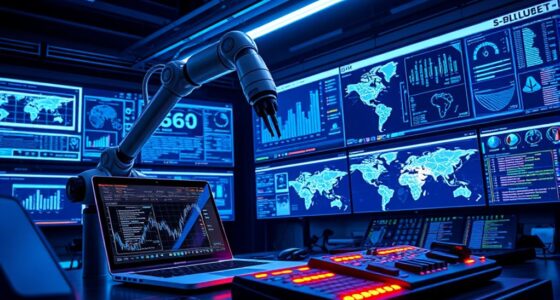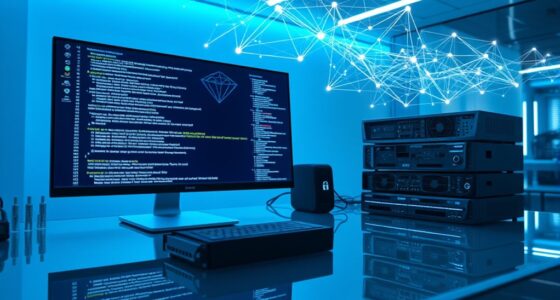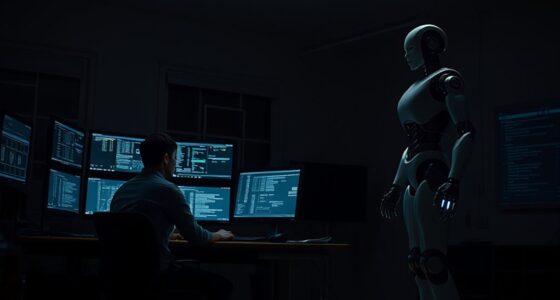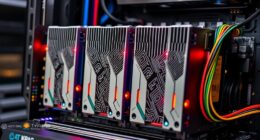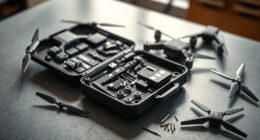To trace a deepfake’s creator, investigators analyze metadata, looking for clues about the software and device used. They examine video artifacts like unnatural blinking or shadows to spot manipulation signs. Reverse-engineering AI models can reveal specific tools or platforms involved. Digital footprints, such as upload history and IP addresses, help identify the origin. Combining these methods increases accuracy, and if you’d like to explore how these techniques work together, there’s more to discover.
Key Takeaways
- Investigators analyze metadata for device, software, and timestamp clues, though this can be manipulated or removed by creators.
- Forensic video analysis detects artifacts like unnatural blinking or shadows characteristic of deepfakes.
- Reverse engineering AI models reveals unique “fingerprints” linking videos to specific deepfake generation tools.
- Digital footprints, such as upload history and IP addresses, help trace the origin and creator’s online activity.
- Combining metadata, forensic analysis, reverse engineering, and digital forensics enhances attribution accuracy.
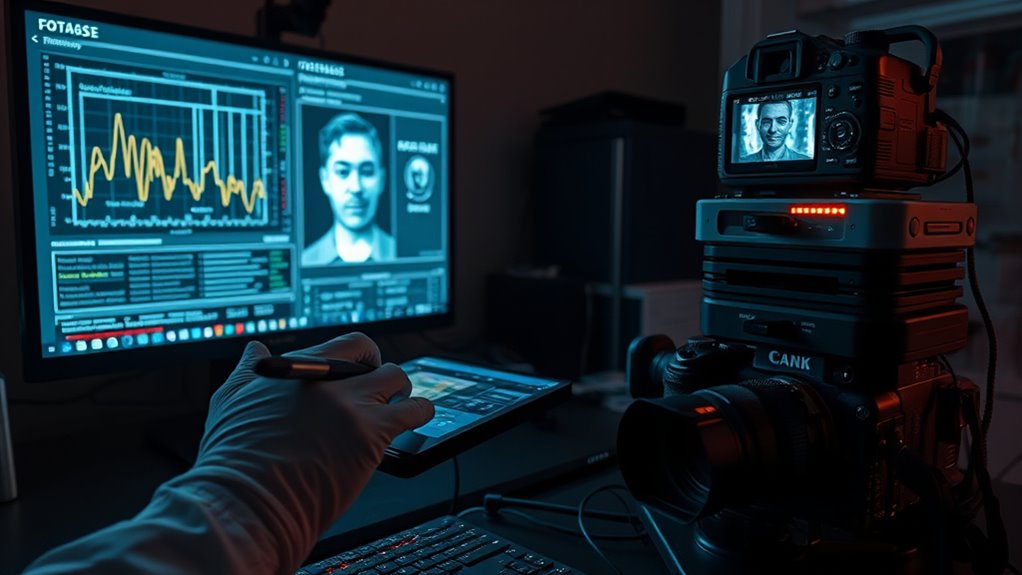
Have you ever wondered how to determine who created a deepfake? It’s a question that puzzles many, especially as these manipulated videos become more sophisticated and harder to spot. When investigators step into this arena, they rely on a combination of technical analysis, digital forensics, and sometimes even behavioral clues to trace the origin of a deepfake. First, they examine the digital footprint left behind during the creation process. Every digital file, including videos, images, and associated metadata, carries traces of its journey. By analyzing metadata, investigators can sometimes identify the software used, the device that captured the footage, or even the time and location of creation. However, this data isn’t foolproof; savvy creators can manipulate or remove metadata to obscure their trail. That’s why investigators often look beyond metadata, turning to forensic techniques that analyze the video’s technical characteristics.
Investigators analyze metadata and technical traits to identify deepfake creators and trace their digital footprints.
One key approach involves scrutinizing the video for inconsistencies or artifacts that might reveal its artificial nature. Deepfakes often leave behind subtle signs—unnatural blinking, irregular shadows, mismatched facial expressions—that can be detected through specialized software. But beyond identifying the fake, forensic experts seek clues about its origin. They analyze pixel patterns and compression artifacts to see if they match known signatures of particular editing tools or AI models. Sometimes, they compare the deepfake against a database of known deepfake signatures, which can help narrow down the software or even the user behind it. Additionally, understanding the resources and tools used in creation can provide critical insights into the origin.
In recent years, investigators have also turned to reverse engineering the AI models used to generate deepfakes. By examining the specific neural network architecture or the unique “fingerprints” left by certain algorithms, they can sometimes trace the creation back to a particular tool or platform. This process involves deep technical analysis, but it can provide essential leads, especially if the creator used a proprietary or identifiable model. Social media footprints and digital activity logs further assist the investigation. If the creator uploaded the deepfake to a platform, analyzing IP addresses, account histories, or associated devices can reveal who might be behind it. Sometimes, digital forensics uncover leaks or trace back to initial upload points, offering investigators their best chance at identifying the source.
Ultimately, pinning the creator of a deepfake demands a multi-layered approach—combining technical analysis, forensic investigation, and digital sleuthing. While no method guarantees 100% certainty, these strategies greatly increase the odds of uncovering who made the fake. As technology advances, so do the tools to fight back, equipping investigators with sharper techniques to hold malicious creators accountable.
Frequently Asked Questions
What Are the Latest Tools Used for Deepfake Detection?
You can use tools like Microsoft Video Authenticator, which analyzes videos for subtle signs of manipulation, or Deepware Scanner that detects deepfake content through AI algorithms. Additionally, tools like Sensity AI and Amber Video help identify deepfakes by analyzing inconsistencies or artifacts. These tools rely on machine learning, forensic analysis, and blockchain verification to pinpoint fabricated videos, empowering you to better detect and respond to deepfake content effectively.
How Can Creators Protect Their Digital Signatures From Misuse?
You can safeguard your digital signatures by using ultra-secure encryption methods and blockchain technology. Think of it as putting your signature in a vault that’s impossible to crack. Always keep your private keys private, update your security protocols regularly, and use multi-factor authentication. These steps create an impenetrable barrier, ensuring your digital signatures stay yours alone, preventing misuse and maintaining your creative integrity in the digital world.
What Legal Actions Exist Against Deepfake Creators?
You can pursue legal actions like filing criminal charges for fraud, defamation, or identity theft, depending on the misuse of deepfakes. Civil lawsuits also exist for damages caused by false representations or invasion of privacy. Some jurisdictions are developing new laws specifically targeting deepfake creation and distribution. By taking these steps, you hold creators accountable and deter future malicious use of deepfake technology.
How Effective Are Current Forensic Techniques in Tracking Deepfake Origins?
Current forensic techniques are quite effective in tracking deepfake origins, but they’re not foolproof. You can find digital fingerprints, analyze watermark patterns, and examine metadata to identify the creator. However, savvy creators often use sophisticated methods to hide their tracks, making attribution challenging. While technology advances, you’ll need a combination of digital forensics and investigative work to improve your chances of pinning down who made the deepfake.
Can Blockchain Technology Verify the Authenticity of Deepfake Videos?
Yes, blockchain technology can verify the authenticity of deepfake videos. You can use blockchain to create a secure, tamper-proof record of original video files, making it easier to verify their authenticity. When you upload a video, its hash gets stored on the blockchain, and any alterations can be detected by comparing current data with the stored record. This process helps you confidently distinguish genuine videos from manipulated ones.
Conclusion
So, next time you’re fooled by a convincing deepfake, remember—you’re just a click away from the detective’s toolkit. With experts constantly honing their craft, the real mystery isn’t who made it, but whether you’ll ever trust your eyes again. In a world where anyone can be a digital Picasso, maybe the real art is in figuring out who’s behind the brush—and whether they’re even human. Trust no one, especially not your own eyes.



